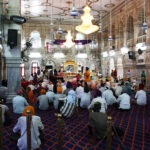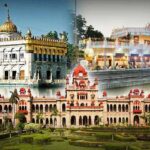Gurudwara Harmandir Sahib
Gurudwara Harmandir Sahib, also known as the Golden Temple, is the holiest Gurdwara and the most important pilgrimage site in Sikhism.
The foundation of Harmandir Sahib was laid by Guru Arjan Sahib, the fifth Guru of Sikhism, in December 1588. It was Guru Arjan who conceived the idea of creating a central place of worship for the Sikh community.The construction of the temple was initiated by Guru Arjan himself, and it took several years to complete. The construction was completed in 1604. It Is Constructed With Normal Stuff Such As Marble, Bricks, Cement Etc. But After That It Got Covered With 24 Karat Gold By Maharaja Ranjit Singh. There Is Almost 500 Kg Gold Plated At Golden Temple Costing Around ₹1.3 Arab Or ₹130 Crore (₹1,30,00,00,000). 160 Kg More Gold Was Added A Decade Ago.

Harmandir Sahib as a Symbol of Sikhism
Gurudwara Harmandir Sahib is not only a place of worship but also a symbol of equality, humility, and service. The concept of Langar (community kitchen) was introduced by Guru Nanak and is practiced at the Golden Temple, where free meals are provided to all visitors, regardless of their background.
It was built as a place of worship for all religions, and is considered the holiest Gurdwara of Sikhism. The symbolic openness of the Sikhs is represented by the four entrances used to enter the Gurdwara. It also includes the world’s largest free kitchen, capable of serving food to 300,000 people a day.
Gurudwara Ber Sahib
Gurdwara Ber Sahib is an important Sikh place in Sultanpur Lodhi, Punjab, India. It’s special because it’s connected to Guru Nanak Dev Ji, who started Sikhism. The place has a lot of history and is a meaningful site for Sikhs.
The present building of Gurudwara Ber Sahib was built by Maharaja Jagatjit Singh of Kapurthala. The cornerstone was laid by Bhai Arjan Singh of Bagarian on 25 February 1937, and the Gurudwara was on completion dedicated by Lieutenant General Maharaja Yadavinder Singh of Patiala on 26 January 1941.

Gurdwara Ber Sahib is situated near the sacred Ber tree, under which Guru Nanak Dev Ji is believed to have meditated for 14 years, 9 months, and 13 days. The Ber tree is considered to be the same under which Guru Nanak attained enlightenment.
Gurdwara Damdama Sahib
Damdama Sahib is an important place, especially for Sikhs. Long ago, Guru Teg Bahadur, who was Guru Gobind Singh’s father, visited this place. Damdama Sahib is like the main office for a group called Nihangs. So, it’s historically significant for Sikhs and an important center for the Nihangs.
The pious place associated with Guru Nanak Dev Ji’s marriage is known as Batala. In 1487 A.D., Guru Nanak Dev Ji came to Batala as a bridegroom from Sultanpur Lodhi. This event is part of the early life of Guru Nanak, the founder of Sikhism.

The historical significance lies in the fact that Batala was the place where Guru Nanak Dev Ji entered into the bond of marriage. The marriage ceremony took place in Batala, and it is remembered as an important event in Sikh history. Pilgrims and followers visit Batala to pay homage to this sacred site and to connect with the early life events of Guru Nanak Dev Ji. The place holds cultural and religious importance as it marks the beginning of Guru Nanak’s family life.
Gurdwara Shri Baoli Sahib Goindwal Sahib
Gurdwara Shri Baoli Sahib is located in Goindwal Sahib, a town in Tarn Taran district, Punjab, India. The Goindwal Baoli is the first sacred place for Sikhs, and Guru Amar Das Ji, the third Sikh Guru, made it in the 16th century. Guru Amar Das Ji lived in Goindwal for 33 years. During his time there, he built a special well called a Baoli with 84 steps. The entrance to the well is beautifully decorated. This place is important for Sikhs because it holds the history of Guru Amar Das Ji and the spiritual significance of the Baoli.

Guru Amar Das, like Guru Nanak and Guru Angad before him, helped gather and organize the hymns and teachings of the first three Gurus. With Guru Amar Das’s guidance, these writings were compiled into a sacred book called the Adi Granth. This book eventually became the Guru Granth Sahib, which is the holy scripture of Sikhism. So, Guru Amar Das played an important role in preserving and continuing the spiritual teachings of the earlier Gurus.
Gurudwara Chheharta Sahib
Gurudwara Chheharta Sahib is a special place for Sikhs in Amritsar, Punjab, India. It’s important because it’s connected to Guru Hargobind Sahib Ji, the sixth Guru of the Sikhs. Guru Hargobind Sahib Ji made this place significant by establishing a sacred pond and a Gurdwara here. People visit to take a dip in the holy water, pray, and feel a sense of community.
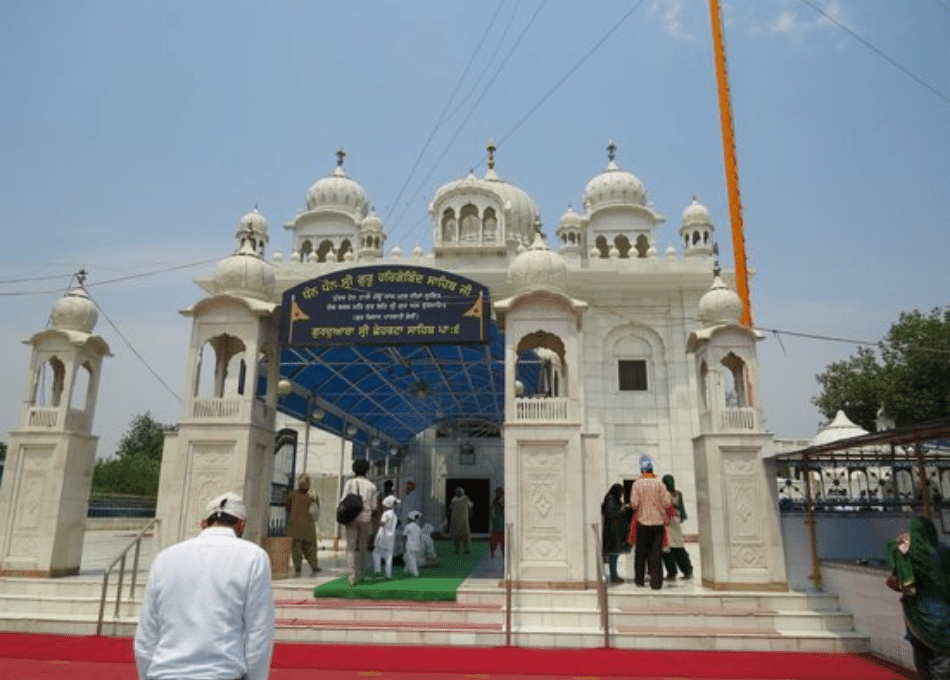
Guru Hargobind Sahib Ji played a crucial role in shaping the military and spiritual aspects of Sikhism. The establishment of Gurudwara Chheharta Sahib reflects the Guru’s commitment to providing essential amenities and promoting a sense of community.
Gurudwara dera Sahib
Gurdwara Sri Dera Sahib Lahore is situated near the Badshahi Masjid. After many days of torture, Sri Guru Arjan Sahib Ji disappeared into the river Ravi here and re-joined with God.
Muslims began their history of Sikh genocide when they tortured Sri Guru Arjan Sahib Ji, a pious and holy man who helped others and did much good.Guru Arjan was allowed to take a bath in the river Ravi, to cool his many burns, by his guards. At the time, the Ravi flowed along the wall of the fort. The Guru’s light rejoined Akal Purakh on 30th May 1606.

Sri Guru Hargobind Sahib Ji visited the site of his father’s torture in 1619 where he had a memorial rostrum built to commemorate the martyrdom of Guru Arjan. Later Maharaja Ranjit Singh had a small but beautiful Gurdwara built here.As the Maharaja’s Gurdwara had no congregational hall, one was attached to Gurdwara in 1909, after which daily congregations were regularly held. After that a sarai (rooms for visitors) and a marble gate was built along with a Nishan Sahib (flag post).
In 1925 A.D. a local committee was formed to tend to the Gurdwara, which was replaced when in 1927, the SGPC took over the management and started rebuilding the Gurdwara on 21st April 1930. The work was completed on 9th September 1934, including resurfacing the domes in gold. Then the clay areas to each side of the Gurdwara were paved.
The number of Sikhs in daily congregations soon increased necessitating further plans to extend the Gurdwara’s capacity. Plans were drawn out, but due to the partition of the country, they could not be accomplished. On 9th September 1947, after all of the hard work on the Gurdwara, Sikhs had to abandon their gurdwara to save their lives.
Gurudwara Guru Ka Mahal
Gurudwara Guru Ka Mahal was built as a humble hut in 1573 CE by Guru Ram Das Ji, the 4th Sikh Guru. It was the residential house of Sri Guru Ram Das, the founder of Amritsar. Guru Arjan Dev got married as well as appointed as a Guru in this Mahal. Baba Atal Rai and Sri Guru Tegh Bahadur were born at this place and Sri Guru Hargobind Singh was also lived here for some time. Later, it was enlarged and modified by Guru Arjan Dev and his son, Guru Hargobind. Now it has been converted into a gurudwara.
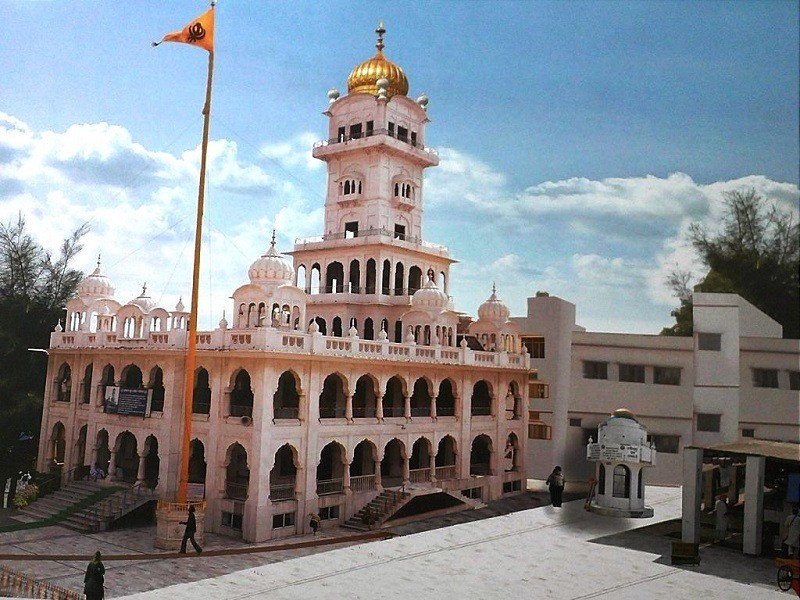
Guru Hargobind Sahib Ji was a special leader, known for both his spiritual teachings and military skills. He transformed the Sikh community during tough times. Gurudwara Guru Ka Mahal was built in the early 17th century. People visit it to remember Guru Hargobind Sahib Ji and find spiritual guidance. Inside, there’s a prayer hall where the Guru Granth Sahib, the holy Sikh scripture, is honored.
Gurudwara Gurusar Satlani
Gurudwara Shri Gurusar Satlani Sahib is in Hoshiar Nagar village, District Amritsar. It’s special because it marks a stop made by Guru Hargobind Sahib Ji during his trip from Lahore to Amritsar. Gurudwara Shri Gurusar Satlani Sahib was built to remember and honor this specific stop made by Guru Hargobind Sahib Ji. “Satlani” means a place where you stay for the night.

Gurdwara Sri Gurusar Satlani Sahib is located 1.5 km south of Satlani railway station. 1.5 km further to the south is village Hoshiar Nagar. The Gurdwara marks the spot where Sri Guru Hargobind Sahib Ji, travelling from Lahore to Amritsar, stopped for the night near a pond. According to local tradition, Sri Guru Gobind Singh Ji appointed one of his Sikhs, Bulaka Singh, as the custodian of this Gurdwara. The Gurdwara was richly endowed by Sikh rulers and chiefs during the first half of the nineteenth century. The management of the Gurdwara along with its vast farmlands passed to the Shiromani Gurdwara Parbandhak Committee in 1925. In 1974, it was renovated by Bhai Marigal Singh.
Gurudwara Kaulsar Sahib
Behind the Golden Temple in Amritsar, there’s a special Sikh shrine known as Gurudwara Mata Kaulan or Gurudwara Kaulsar Sahib. It’s quite famous and attracts a lot of tourists.This gurudwara is named after Bibi Kaulan, who was a devoted follower of Guru Har Gobind. People still remember her singing hymns passionately every evening.
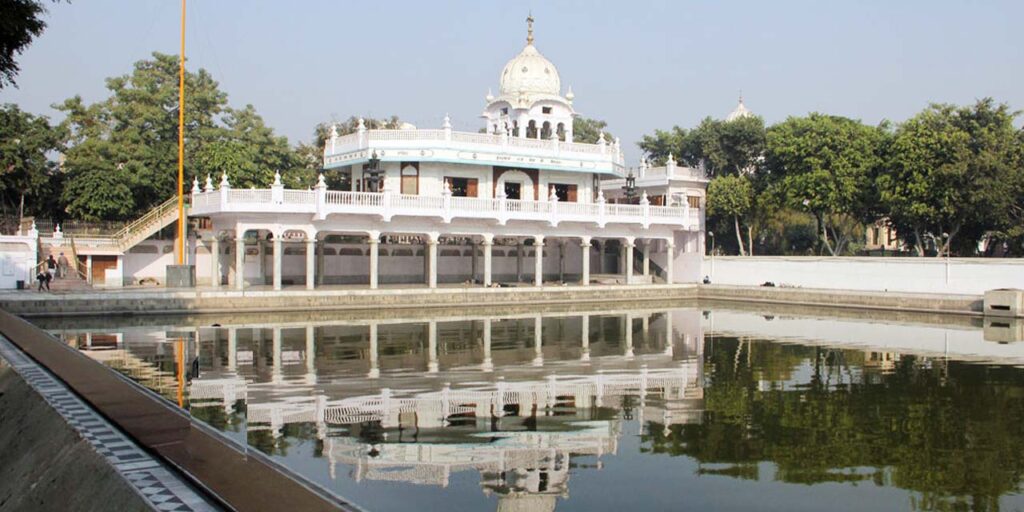
Next to Gurudwara Mata Kaulan, there’s a pool called Kaulsar Sahib. It got its name from Bibi Kaulan, who was a Muslim follower of the Sikh Gurus. Here’s an interesting fact: Baba Budha Ji, the first head reader at the Golden Temple, oversaw the digging of Kaulsar. They started in 1624 and finished in 1627. Kaulsar is one of the five sacred pools in Amritsar.
Guru Har Gobind suggested that before visiting the main Amrit Sarovar, followers should take a dip in the holy Kaulsar Sarovar.A fun fact: Kaulsar Sarovar is the first shrine to bear a Muslim woman’s name. It’s a special place that holds historical and spiritual significance.
Gurudwara Lohgarh Sahib
Lohgarh Sahib Fort, also known as the Iron Fort, is situated about 30 kilometers from Sadaura. It holds a special place in history because of its connection to Guru Hargobind Sahib, the sixth Sikh Guru. Lohgarh Sahib Fort was made to be a strong and secure place. It served as a protective fortification for the Sikh community during uncertain times.

A person named Bhai Lakhi Rai Wanjara built the fort. He was a devoted follower of Guru Hargobind Sahib. Guru Hargobind Sahib, realizing the need for a strong and safe place, told Bhai Lakhi Rai Wanjara to make Lohgarh Sahib Fort. This happened during a time when there were challenges and the Sikh community needed a protected space.
The building of the fort began around the 1620s. This was during the leadership of Guru Hargobind Sahib when the Sikh community was growing and facing different situations. It took many years to finish building the fort, and it was finally completed in 1710. Constructing such a place required time, effort, and resources. The fort reminds people of Guru Hargobind Sahib’s leadership and the importance of safeguarding their beliefs. It shows the spirit of the Sikh community in protecting their way of life.

